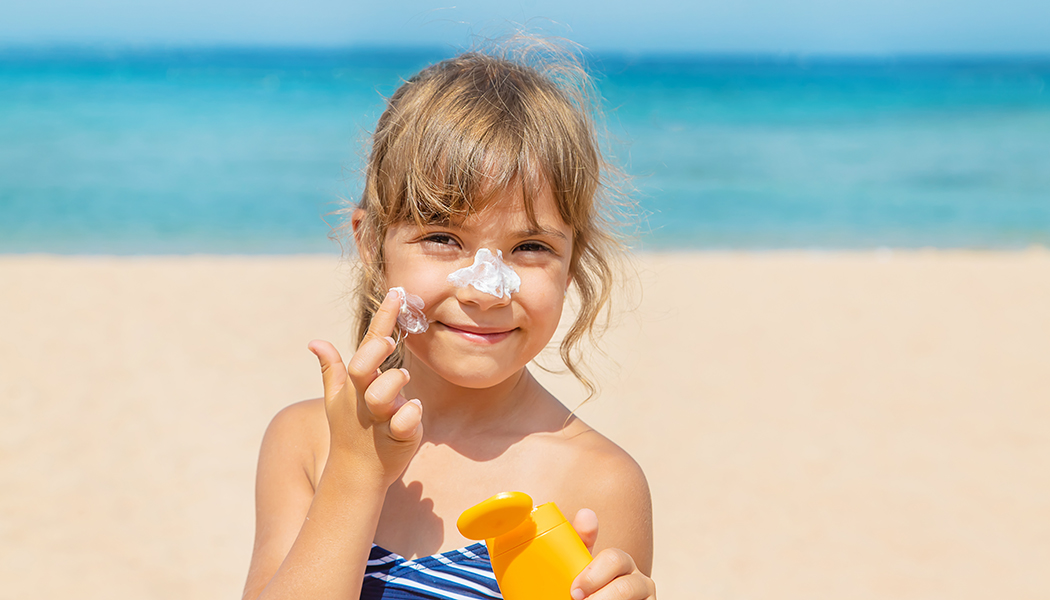9 Must-Know Facts About Sunscreen

Sunscreen is one of the most important tools in the prevention of skin cancer. Learn more about how to choose and correctly use a good sunscreen for you and your family.
With the arrival of warm summer weather, states have started to relax their COVID-19 stay-at-home orders. Excited to spend time with family and friends, people are now planning vacations, with one destination remaining a popular choice for many: the beach. However, extra time spent soaking up the sun increases our exposure to harmful ultraviolet (UV) radiation and raises our risk for developing skin cancer.
July is UV Safety Month. We know that one of the best ways to practice UV safety is to wear sunscreen every day. To help you choose and correctly use the best product for your needs, review the nine facts about sunscreen listed below.
Fact #1: Broad Spectrum Sunscreens are Best
UV radiation from the sun includes two types of harmful rays:
- Ultraviolet A (UVA) Rays: Most common; cause premature aging of the skin (e.g., wrinkles)
- Ultraviolet B (UVB) Rays: Most dangerous; cause sunburns
Overexposure to both types of rays can cause skin cancer. Sunscreens labeled as “broad spectrum” help protect against the effects of both UVA and UVB rays.
Fact #2: Aim for a Sunscreen with at Least 30 SPF
A sunscreen’s sun protection factor (SPF) indicates how much protection the product offers against UV radiation. Sunscreens with an SPF of at least 30 block 97 percent of the sun’s rays.
Fact #3: No Sunscreen is Waterproof or Sweat Proof
Manufacturers can no longer advertise sunscreens as waterproof or sweat proof. Instead, products are now labeled:
- Water Resistant: Effective for up to 40 minutes in water
- Very Water Resistant: Effective for up to 80 minutes in water
The AAD recommends reapplying sunscreen every two hours, after getting out of the water, or after sweating.
Fact #4: Children Under Six (6) Months Typically Should Not Wear Sunscreen
Infant skin is more sensitive than adult skin. To protect infants younger than six months, the AAD recommends keeping them in the shade as much as possible; dressing them in protective clothing, such as long-sleeved shirts, pants, and a wide-brimmed hat; and making sure they stay hydrated. If you are still concerned about sun exposure, ask your pediatrician if he/she recommends sunscreen.
 Fact #5: Sunscreen is Only One Tool in Your UV Safety Toolbox
Fact #5: Sunscreen is Only One Tool in Your UV Safety Toolbox
There are many ways to reduce your exposure to UV radiation. Experts recommend combining sunscreen use with wearing protective clothing, staying in the shade when possible, and avoiding outdoor activities when the sun is most intense.
Fact #6: Use “Teaspoon and Shot Glass Rule” to Determine How Much Sunscreen to Apply
Many people do not apply enough screen. The “Teaspoon and Shot Glass Rule” recommends using one teaspoon of sunscreen to cover the face and neck, and enough sunscreen to fill a shot glass — approximately one ounce — to cover all other exposed areas on the body.
Fact #7: Sunscreen Expires
According to the AAD, the FDA requires all sunscreens to retain their original strength for at least three years. Many sunscreens include an expiration date printed on the label. Visible changes in color or consistency can also indicate that it is time to dispose of the product.
Fact #8: Spray-On Sunscreens Are Convenient, But Not Always Effective
The AAD explains that current FDA regulations on testing and standardization do not apply to spray-on sunscreens. Individuals who want to use spray-on sunscreen should make sure to use an adequate amount, rubbing it in to thoroughly cover all areas of exposed skin.
Fact #9: Sunscreen is Safe to Use
Some recent news stories have called into question the safety of the ingredients used in sunscreens, but sunscreen remains completely safe to use and is recommended by all health care professionals. Read more about this in our blog post titled “Is Sunscreen Safe?”
Learn More: How NFCR is Advancing Skin Cancer Treatment
Research conducted by the National Foundation for Cancer Research’s (NFCR) scientists Danny R. Welch, PhD; Paul Fisher, MPh, PhD; Web Cavenee, PhD; and Helmut Sies, M.D., continues to play a critical role in our understanding of this complex disease, including potential advances in treatments for melanoma — the most dangerous type of skin cancer.
To learn more about skin cancer research supported by NFCR, please visit our Skin Cancer webpage.
Additional Reads You May Enjoy:
Related Video:



 Fact #5: Sunscreen is Only One Tool in Your UV Safety Toolbox
Fact #5: Sunscreen is Only One Tool in Your UV Safety Toolbox







